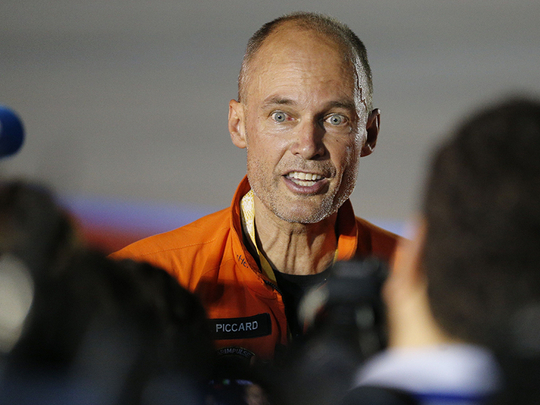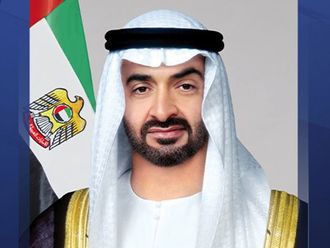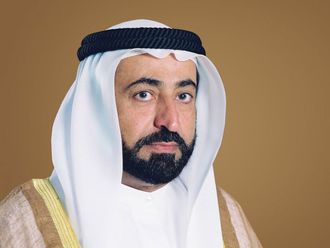
Abu Dhabi: Bertrand Piccard, the initiator and chairman of the “Solar Impulse” project, said, late Shaikh Zayed Bin Sultan Al Nahyan, the founding father of the UAE, was a great leader who explained to people why they need to do things.”
Speaking of spreading a culture of pioneering and innovation, Piccard said, “It takes leading by example more than management, in management you tell [people] what to do, in leadership, you tell people why to do it.”
Piccard told the majlis of His Highness Shaikh Mohammad Bin Zayed Al Nahyan, Crown Prince of Abu Dhabi and Deputy Supreme Commander of the UAE Armed Forces, a solar-powered plane that transports about 50 people will be feasible in less than 10 years. Andre Borschberg, who is the CEO and cofounder of Solar Impluse S.A since 2004, said he believes it would take five years to make solar-powered commercial plane feasible.
Piccard said, “Solar Impluse was initiated to show a new vision for technology. How can we inspire people and governments to be cleaner and more profitable? The world of aviation is an inspiring one, that’s why in our view, an air plane serves to inspire people. The Crown Prince of Abu Dhabi was [among] our biggest supporters, he told us, ‘You have to fly it from here’ even before we had an air plane.”
“When I arrived in Abu Dhabi … it was the best part of the flight, the best part of the project, but it took us 15 years to do it.”
The Ramadan Majlis of Shaikh Mohammed Bin Zayed Al Nahyan hosted a lecture by Solar Impulse pilots Andre Borschberg and Bertran Piccard at Al Bateen Palace in Abu Dhabi.
The lecture commenced with the playing of a short video that featured the two pioneering pilots of Solar Impulse talking about their passion for flying around the world without spending a drop of fuel. The film then moved to show the different cities that Solar Impulse landed in after taking off from Abu Dhabi. The plane flew 40,000 kilometres around the world, fully fuelled by sun light. The journey is longer than any conventional jet has ever taken.
“When I arrived in Abu Dhabi … It was the best part of the flight, the best part of the project, but it took us 15 years to do it.”
Borschberg said it’s a special feeling to be back here in Abu Dhabi, with a lot of memories. “What was great about [the round trip] was that it was a good opportunity to talk about what you do in your country … projects like Masdar. It’s fantastic to be back in your wonderful place.”
Aviation experts were quick to dismiss their flight as impossible, given how much solar energy could be captured and how much an average air plane needed to get off the ground. So the pilots shifted the paradigm, and focused on energy consumption rather than production, on energy efficiency. It took some time, but ultimately the motors on Solar Impulse reached 97 per cent efficiency, more than three times as efficient as most combustion engines. All this with a plane whose wingspan exceeded that of a Boeing 747, yet remained lighter than a family car.
This exploit was a voyage of discovery — both technical and personal — bringing together two people from very different worlds; Bertrand Piccard is a psychiatrist and explorer, André an engineer and an entrepreneur. Their very different backgrounds and experiences complemented one another and, united by a common vision, forced each other further to find solutions that neither of them possessed on their own.
Piccard said: “When we allowed ourselves to challenge each other, it wasn’t anymore one plus one equals two, it was one plus one equals three.” He stressed the importance of working with each other, saying: “You cannot be right alone, you cannot reach the truth alone. The goal wasn’t to be better than other anyone, it was to be better than ourselves.”
Speaking about his role in the project, Borschberg said he focused on the strategy. “I knew that this aircraft will be built from carbon fibre, so I looked for companies that make this material but also companies that are innovative.” He said it took two years to create the links from carbon fibre engineers and aerodynamics engineers, adding that changing mind sets was an important part of the project.
Speaking about the challenges they faced, Piccard said: “The hurdles come from everywhere if you want to do something that hasn’t been done before, because people tell you that you can’t do it because it hasn’t been done before. It can be done only by people who are able to think outside of the box, who aren’t unfortunately many in the world. For one yes, I got 99 nos. So many people tell you it’s impossible. The most important thing to realise is that impossible is only is in the heads of people, not in reality.”
He said changing paradigms was the most important thing when it comes to introducing new ideas and getting people to believe in them.
On the role of media, Borschberg said, “This project would’ve not worked without the media interest.” He said that included traditional as well as new, and social, media. “When you have a solar air plane that has a 72-metre wing span, that is beautiful, then it has an impact … we had billions and billions of media impressions,” Borschberg said.
Responding to a question about what it takes to be a pioneer, Borschberg said it needs a combination of curiosity, perseverance and respect. “Inside of us, we have so much potential. This is important in adventure; confidence is important.” He said education should be about teaching children to be explorers, not just feeding them information.
He noted that, “Passion is very important” for a project like this, adding that one would also need to overcome fear.
Speaking about their vision for the future, Piccard said, “Now, we can go on to the second stage of Solar Impulse, which is to work on the technologies.” Borschberg said, “There are incredible things that can be done. Today, electric propulsion is a major development in the aviation industry.”












